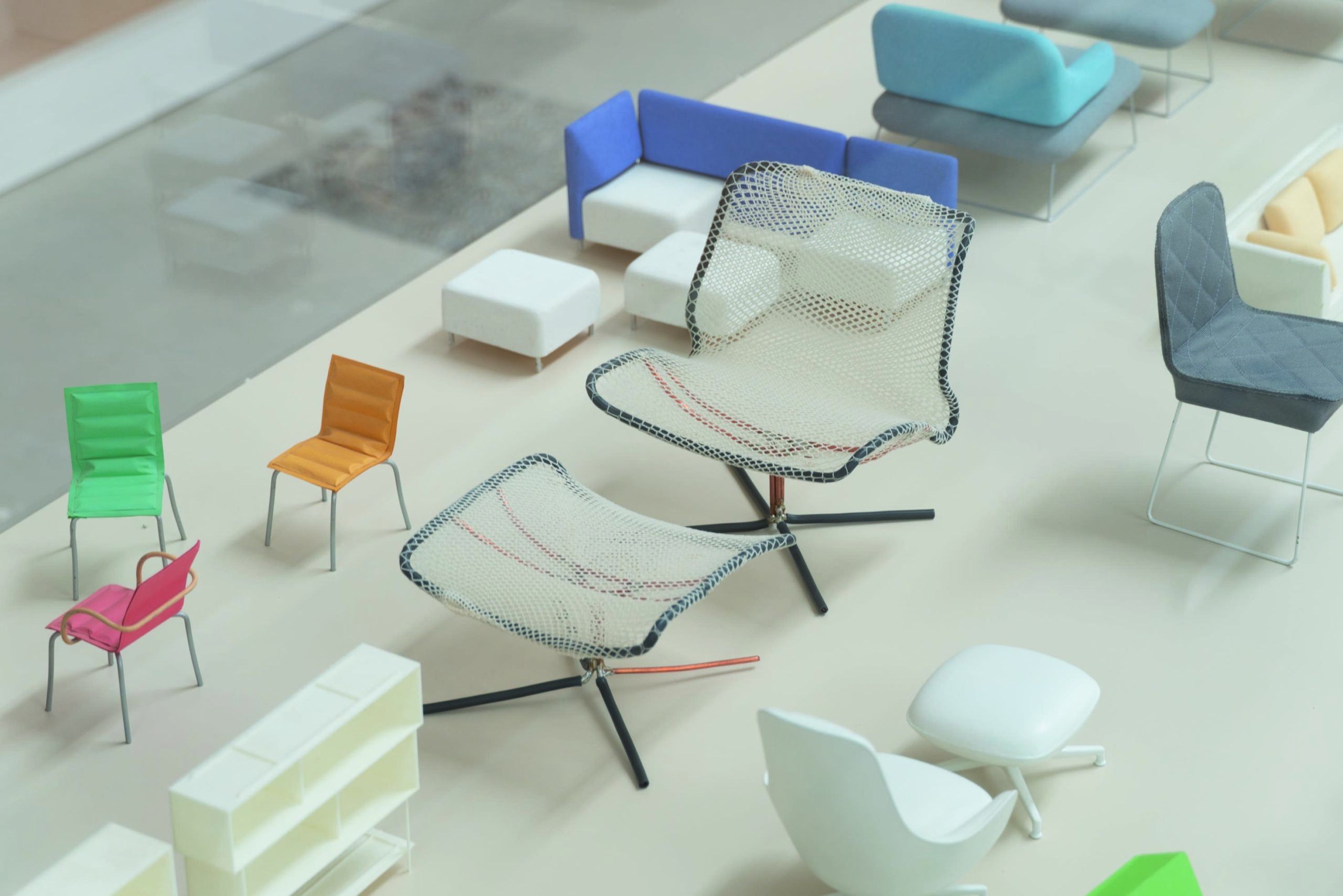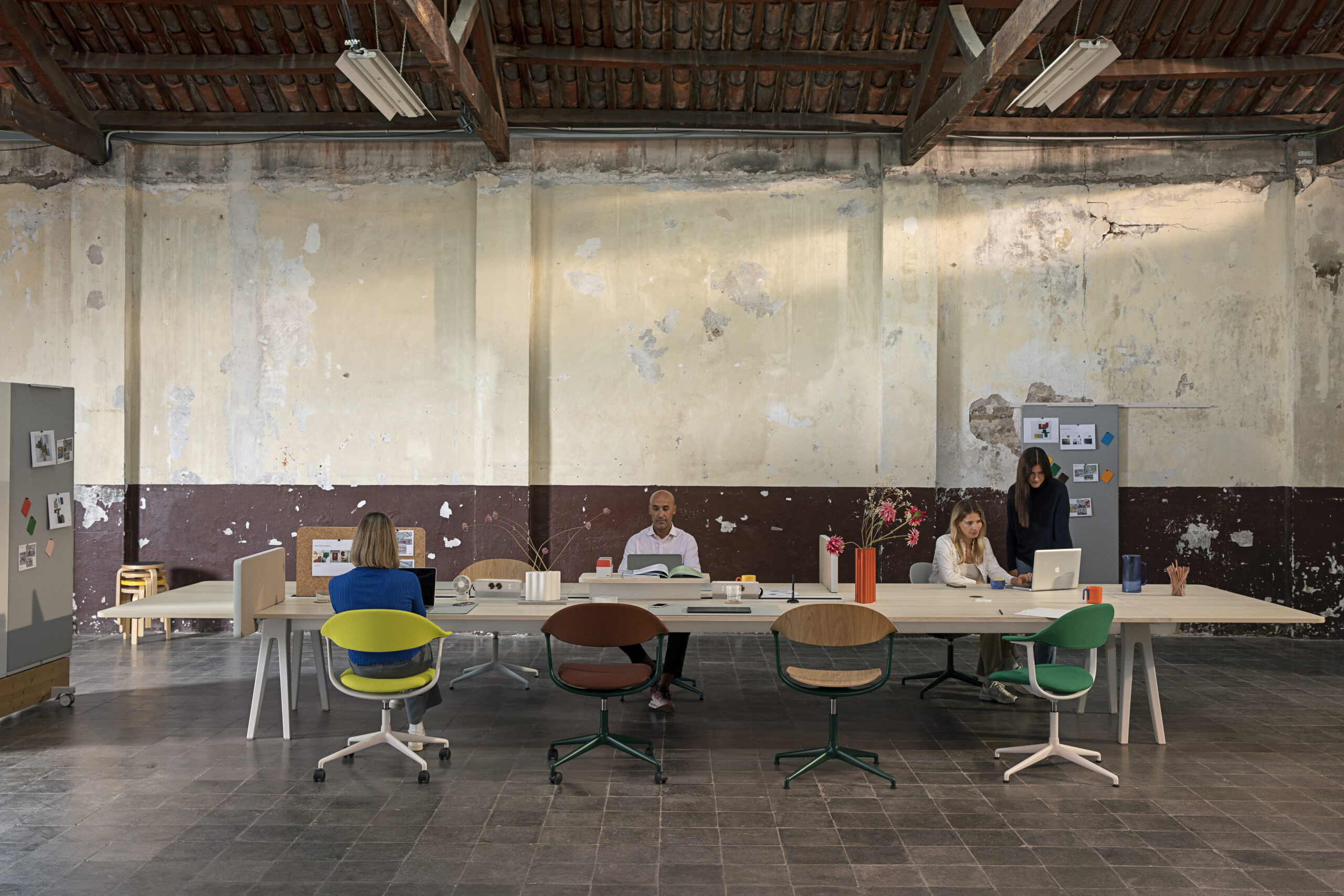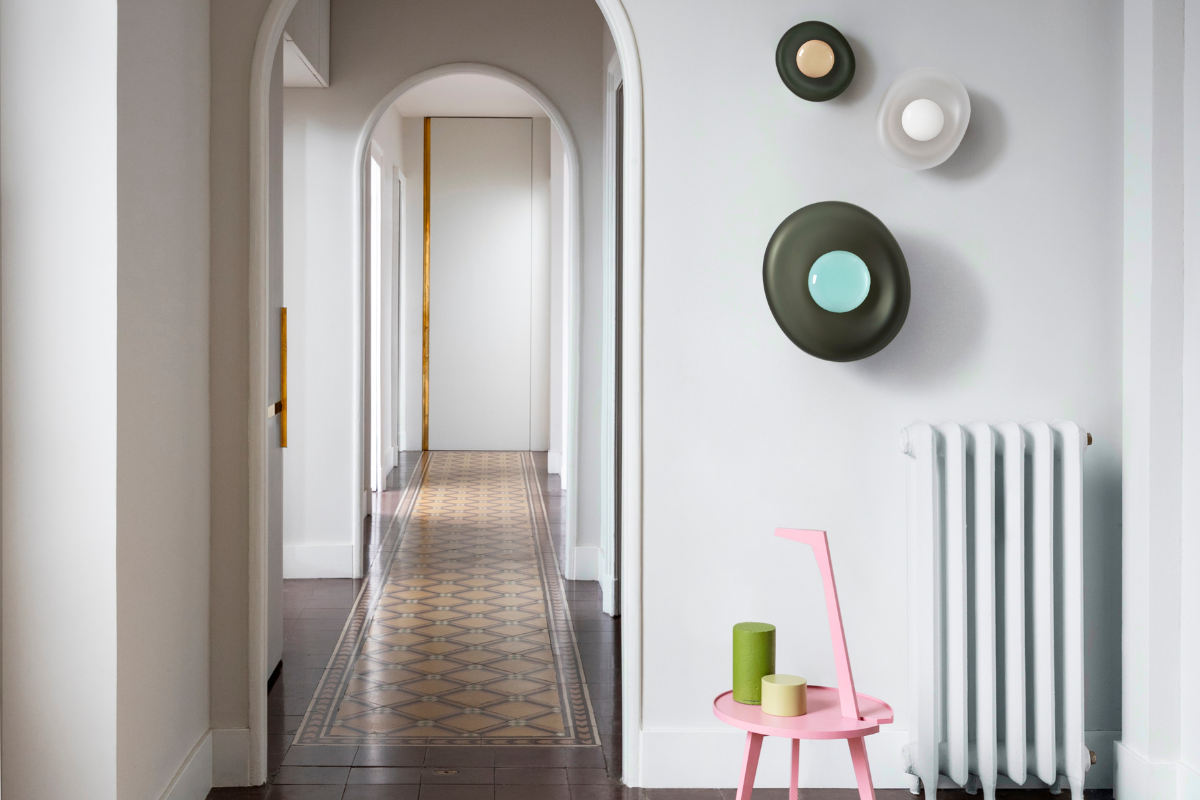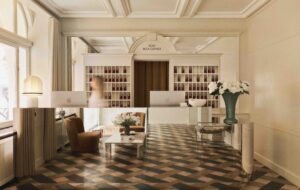
 This year marks the tenth anniversary of PearsonLloyd, the British design studio founded by Luke Pearson (right) and Tom Lloyd. The duo, who design for an A-list client base, are now taking steps towards self-initiated projects.
This year marks the tenth anniversary of PearsonLloyd, the British design studio founded by Luke Pearson (right) and Tom Lloyd. The duo, who design for an A-list client base, are now taking steps towards self-initiated projects.
Kerstin Zumstein visited their London studio to unravel a batch of brand new products
The first time I met Luke Pearson, I had just started working on our launch issue. It was during London Design Week last year, and Pearson asked, without hesitation: “So do you already have a launch cover?” It was clear then that it was never going to be anything less than a cover story for PearsonLloyd. The British designers had exceeded the point of short profile snippets in Wallpaper and had risen to join the design league that future students will be learning about in books.
“When thinking about our break-through point, rather than a product or project it was simply the decision to start our own thing,” Pearson recollects. Lloyd (40) and Pearson (39) met while studying at the Royal College of Art in London, where they now give lectures. There is a certain quality in their work that stems from the two of them training in both product and furniture design. “We’re pluralists,” Pearson says. “Product design is function driven, with clever engineering on the inside, while styling is seen as a dirty word. With furniture, on the other hand, the mantra is – take the Curve chair for example – what you see is what you get.” He talks about the emotive connection to furniture, how people have a relationship with these items. “You keep it because you like it,” he says.
“While products are exchanged frequently,” adds Lloyd. “It’s like two halves of a brain, so studying both gives you
a balanced approach,” concludes Pearson. The same notion seems to apply to the two business partners.
They both feel the importance of intellectually engaging in design and its values, and therefore support
the RCA’s platform system based on experimentation and freedom. “We often show photos in our lectures. We’re real photo junkies,” Lloyd admits. Their meeting room wall is covered in an eclectic mix of images, reporting on cultural phenomena (Japanese rappers) as well as natural textures (pebbles on a beach). On a shelf, various miniature models of PearsonLloyd products are mixed with prototype mock-ups, stuck on mirrors. A mysterious collection of brushes catches my eye. “Yeah, we have a thing for brushes,” says Lloyd. “It’s incredible how many different types of brushes you can find in the hardware stores of various different countries. We’re just fascinated by different cultures, from all angles.”
That inspiration is evident in the diversity of PearsonLloyd designs. The mix of cultural influences makes it tricky to pinpoint English roots. So does different cultures mean different nationalities in this context? The international assortment of PearsonLloyd’s client base is quite exceptional: they have currently developed new products for Italians (Tacchini), Germans (Walter Knoll), British (Allemuir), Americans (Bernhardt), Danish (Danerka) and Japanese (Kokuyo). “It’s a dodgy topic, isn’t it?” says Pearson, “talking about national stereotypes. But I think we should celebrate even our subtle difference. It’s inspiring!” And it’s fun. We talk about the Danish being brutally direct or sitting in a Japanese meeting drinking tea in silence and thinking, “shit, something’s wrong.” The typical British reaction would be to say: “Oh, isn’t this tea nice!” just to break the silence, whereas the Japanese are simply deep in thought about the meeting.
So with such a degree of global clientele, how attached are PearsonLloyd to British design? “Of course it’s refreshing to see how British creativity is resurrecting, with the city of London as a strong focal point,” says Lloyd. “Also that British manufacturers are back, like Senator, who own Allemuir, for instance. It’s great to see they’re prepared to invest so heavily in technology and design now.” Senator invested £200,000 in tools for the development of PearsonLloyd’s cantilever chair Soul, first shown at Orgatec 2006.
The story of Soul is a phenomenon in itself. PearsonLloyd actually did the project twice, in total spending four years on the chair. Initially the pair developed the product for Fritz Hansen. Pearson tells me the amusing anecdote of an important planning meeting with the Scandinavians, when he was pacing the room, deep in thought, and automatically sat down on the €4,000 prototype, which instantly exploded beneath him. “I saw it happen in slow motion, it was highly embarrassing. But supposedly, it’s a classic. It’s claimed Magistretti once sat on a prototype too,” Pearson recalls. “Anyway, the whole project was quite a horror story.” In a nutshell, Fritz Hansen commissioned the ambitious project before deciding a chair made predominantly of plastics didn’t quite fit the bill.
But when Senator saw the prototype they immediately said: “We’ll build it.” The brief was to design a cheap cantilever chair that is ergonomically sophisticated. The end result, for £150, is half the price Fritz Hansen had planned for, and sophisticated isn’t the word – more like super complex or ultra complicated. Pearson springs to his feet and starts demonstrating the chair: “Ok here’s my pitch!” he says, half jokingly – his pride and self-promotion are part of the package. He lifts the chair as if it was a feather. “It’s light for health and safety reasons,” he says. In fact it’s substantially lighter than Citterio’s Vis a Vis, and stackable at 30mm. Pearson places it on the table, with the seat bottom comfortably sitting on the table top – no need to lift high, no scratching of the table surface.
PearsonLloyd clearly exceeded the brief – Soul outshines its competition. It’s a crossover chair, dynamic and flexible and somehow – at the risk of sounding corny – it does have soul. I sit on it for three hours and must admit it is shockingly comfortable. I like the way it promotes movement – you can sit sideways into the armrest and your back still feels supported. Ultimately, the chair is beautiful in its simplicity.
The see-through bottom that Soul is now famous for was initially meant as a joke to celebrate the minimal frame, but everyone loved it and the final fine-tuned production piece will be on show in Design Prima in May. As will Dine, a contemporary version of Arne Jacobsen’s Danish classic 3107, a moulded plywood chair on a tubular steel base, invented in 1955. “Since Jacobsen, everyone has tried to design one,” Pearson says. “The challenge is to design intelligently with the given restrictions. We used conventional veneer but designed mould and profile in parallel, and had to come up with a bespoke shell for under £100.” Production was completed in February 2007. Also, look out for Curve, another chair for Senator with 3D ply, with production completed this February, as well as last year’s Conic and Open.
The form, shape and style of these chairs reflect the confidence and natural ease with which PearsonLloyd designs. At the same time the duo has just finished a desking system for Bernhardt, the American, family-run office design giant. Pearson doesn’t take to my comment that Bernhardt’s general product range isn’t exactly sexy. “They have an incredible set of products and their owner and art director are super savvy. Admittedly though, American design is different.” Lloyd goes for the bigger picture: “Sometimes there is much more room for innovation working with
clients that don’t sit among the traditional top ten design firms. For instance, the Italian firms that led in terms of style for decades have been taken over by a new generation that are often either arrogant or scared of their heritage. It’s more difficult to move things forward and create innovative designs. If you take a company that may be hailed the number one and dissect their products you’ll find that – their classics aside – most products are not that great.”
I’m keen to hear more but Pearson brings us back to the point. “Outline – our new desking range for Bernhardt – is pioneering in different ways.” The system is being launched this month, to be sold internationally but only through US clients.
It turns out this Bernhardt project was a rare pitch for PearsonLloyd, going up against the Bellinis etc, and ultimately the pair presented what they describe as a sculptural response. Outline is an executive desking system – meant for law firms, accountancy firms, investment banking – in essence based on hierarchy and status. The system looks cold, hard, professional. It is at the other end of the spectrum from the Edge table for Danish firm Danerka. We sit at Edge in the pair’s studio. The table is as simple as can be: four screws, a simple frame and drop-in tabletop. I know which one I prefer – the simple, multi-functional, anti-hierarchical Edge. But I guess that’s why I’m not an executive at IBM.
“The company traditionally has this millwork,” Lloyd explains, “for cutting panels, veneering them and putting the parts back together. So we needed to create a design culture that responds to this millwork culture as well as the cost culture of the company. We had ambitions for the project that were more sculptural than this, but what it boiled down to was volume, detail, balancing the brutality of panels with jewellery if you like.” Pearson adds, “It has as much to do with art direction as with design. The chrome balanced timber work represents quality and value. We’re dealing with very subtle design details here that are not always about grand gestures.” I guess you have to see the system in the context of its planned consumers. (Watch out for a new desk lamp that PearsonLloyd will be launching for Bernhardt in conjunction with Outline this May. It will have a stem that rotates by 360º, a touch sensitive switch and hide complex mechanics under its clean finish.)
It seems in many cases the culture is the challenge, not the aesthetics. Another interesting client is Japanese firm Kokuyo, one of the world’s largest companies in its sector – an impressive 5,000 dealers assembled to view the launch of PearsonLloyd’s new Kokuyo bench system. “The Japanese have a different way of working,” Pearson says. “They use the word Okuyuki, which means depth, and that lies at the heart of their creative approach.” The irony here is that the British design team really struggled to decode the initial brief. “Initially we started working to a wrong brief,” Lloyd admits. “They said they wanted a ‘bench system that caters for the individual, a seating system but not a single seater, a system that defines individual space, creates separation’. We didn’t know what the hell they were after.” The end result, however, created in an impressive three months without the designers ever flying out to Japan, is an agile and curious bench curve. There are three different components to it, either formed with an internal 30º corner, an external 30º corner or simply straight. Each element that allows two people to sit on it also has a double V shape cut into the back so that the back portions can flex independently, preventing the usual jolt if the person next to you leans back or forth. The bench modules can be arranged in various ways, automatically creating an interesting pattern.
“A lot of the thinking process we developed while working on Tacchini’s Polar system went into this project,” says Pearson. “After all, when do three people ever want to sit next to each other in a straight line? Either you want to move towards each other and talk or you’d rather move away from each other. It’s like when you watch people on a platform. Strangers will turn an extra ten degrees just to be out of the eye line of the person next to them. That’s the basis of the curve idea.” The Polar system, designed in April 2006, is one of my favourite PearsonLloyd products. I like its ease and flow, and the idea that it is based on the natural forms of icebergs rising out of the sea.
PearsonLloyd also has an impressive array of products for Spanish firm Martinez Otero on the market, with launch products experimenting with ceramics and rugs lined up for Milan. The original colour palettes for the rugs are based on optical kinetics, with shades changing “like fluids and liquids,” Lloyd says, “not that most people would recognise that.” The modular storage system Horizon made quite an impression at London’s 100% Design. “We used mitred joints for drawers and doors to accentuate a sense of volume,” says Pearson. “This volume is then challenged by the introduction of mirrored panels at the ends of each unit, which interacts with both the surrounding architecture and adjacent modules.”
PearsonLloyd has so much going on that after three hours my head is about to burst. There seems no end to the duo’s creative energy and they both seem highly ambitious and enthusiastic about everything they do. Despite the insight they grant me into their new and upcoming projects – and we haven’t even touched on their Virgin fit-out for every single travel class from economy to upper class, the first team to design an entire fleet I believe, not to mention their plans for Transport for London and a bus shelter for Sheffield Council – the best thing about them is that they transfer their passion for design into everything else they do. With the same fervour we discuss cycling in central London, food waste in Hackney, the environment and current outsourcing trends. Suddenly Pearson says, with genuine surprise: “There you are, that’s what I’d like to design one day: a bike!” Can you put me on the waiting list guys?

























